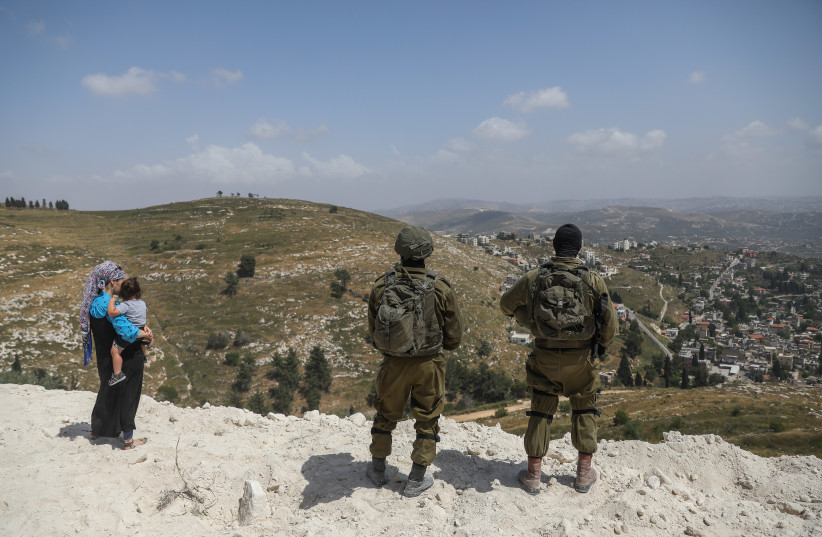The state confirmed that it plans to return Israelis to the site of the northern West Bank settlement of Homesh – which it destroyed in 2005 – and in the initial flush will authorize a yeshiva there.
It issued a statement to that effect in a response it submitted to the High Court of Justice – as part of a protracted legal case about the fate of the hilltop located between the Palestinian cities of Jenin and Nablus.
“The upper political echelon intends to regulate the permanent stay of Israelis there – and significant concrete steps have been taken to that end,” the state’s attorneys said.
All existing state land on that hilltop has once more been placed under the auspices of the Samaria Regional Council, the state said, adding that the council had also been given the authority to promote plans for that site.
It explained that the council had already been working with the Civil Administration’s Higher Planning Council for Judea and Samaria on the preparation for the authorization of such plans.

International disagreement over settlements
The state’s court submission marks the clearest statement to date about the government’s plans for the hilltop, which was the site of one of four northern Samaria settlements that were evacuated after the 2005 Gaza pullout.
It’s a move that is likely to anger the US, which has frowned on any Israeli steps to restore those communities. Washington holds that such a step is a direct violation of longstanding Israeli commitments to the current and past administrations.
Settlers and right-wing activists who had vowed to rebuild the four destroyed communities focused their efforts in particular on Homesh, whose bright orange water tower became symbolic of that pledge.
Students from the yeshiva, which had been located in the original Homesh, illegally returned to the hilltop. They studied in tents and modular structures, which were perpetually rebuilt each time the IDF destroyed them.
Homesh was the only one of the four settlements that was built on private Palestinian property. In 2013, the High Court of Justice returned the land to the Palestinian owners who live in the nearby village of Burka and allowed them to farm that property, but access was difficult, due in part to the presence of the yeshiva on their property.
In 2019 the left-wing Israeli NGO Yesh Din petitioned the High Court to force the state to ensure Palestinian farmers access to their land, including by evacuating Israelis from that hilltop.
It had explained to the court that the 2005 Disengagement Law banned Israelis from accessing the sites of the four evacuated settlements.
In March, the Knesset repealed the Disengagement Law as it applied to northern Samaria and the IDF lifted its ban on the sites. The state in its legal brief to the court noted this significant legal change.
It added that the yeshiva had since relocated to a tract of state land on the site and was no longer on private Palestinian property.
The state acknowledged that the yeshiva had relocated there in advance of legal authorizations, but asked the court to forgive that transgression given that the move was in keeping with the government’s policy of placing Israelis at the site.
“The building found on state land is in principle consistent with the upper political echelons goal that it is promoting through planning procedures that are taking place during these very days,” the state explained to the court.
It added that evacuating illegal Israeli structures on state land in Judea and Samaria was “not high” on its priority list.
Samaria Regional Council head Yossi Dagan welcomed the state’s commitment to returning Israelis to Homesh.
He is among those who believe that Palestinian terror in northern Samaria, particularly in the city of Jenin, is a direct result of the 2005 evacuation of the settlements of Homesh, Sa-Nur, Gadim, and Kadim.
Dagan, who is an evacuee of Sa-Nur, said he believed that authorization of the Homesh Yeshiva would be just a first step toward the reconstruction of the four settlements.
“The northern Samaria settlements are a safety belt for the state of Israel,” Dagan said.
Yesh Din said the state’s response was a formal acknowledgment that Prime Minister Benjamin Netanyahu’s government sought to rebuild a settlement evacuated during the 2005 Disengagement.
It’s a plan that completely “ignores” the property rights of the Palestinians to that hilltop, it charged.
Yesh Din accused Attorney-General Gali Baharav-Miara of caving in to the dictates of Finance Minister Bezalel Smotrich, who also holds a ministerial position in the Defense Ministry and is in charge of settlement construction.
While Baharav-Miara “is fighting the legal coup and the creation of a dictatorship within the Green Line, she has allowed the upper political echelon to strengthen the dictatorship and Jewish supremacy in the West Bank,” Yesh Din charged.
Separately on Friday morning, the left-wing NGO Peace Now held a joint march in northern Samaria with Israeli activists and Palestinians from Burka to demand the evacuation of Homesh. According to participants, the march was disrupted by the IDF, which threw tear gas at the protesters.
